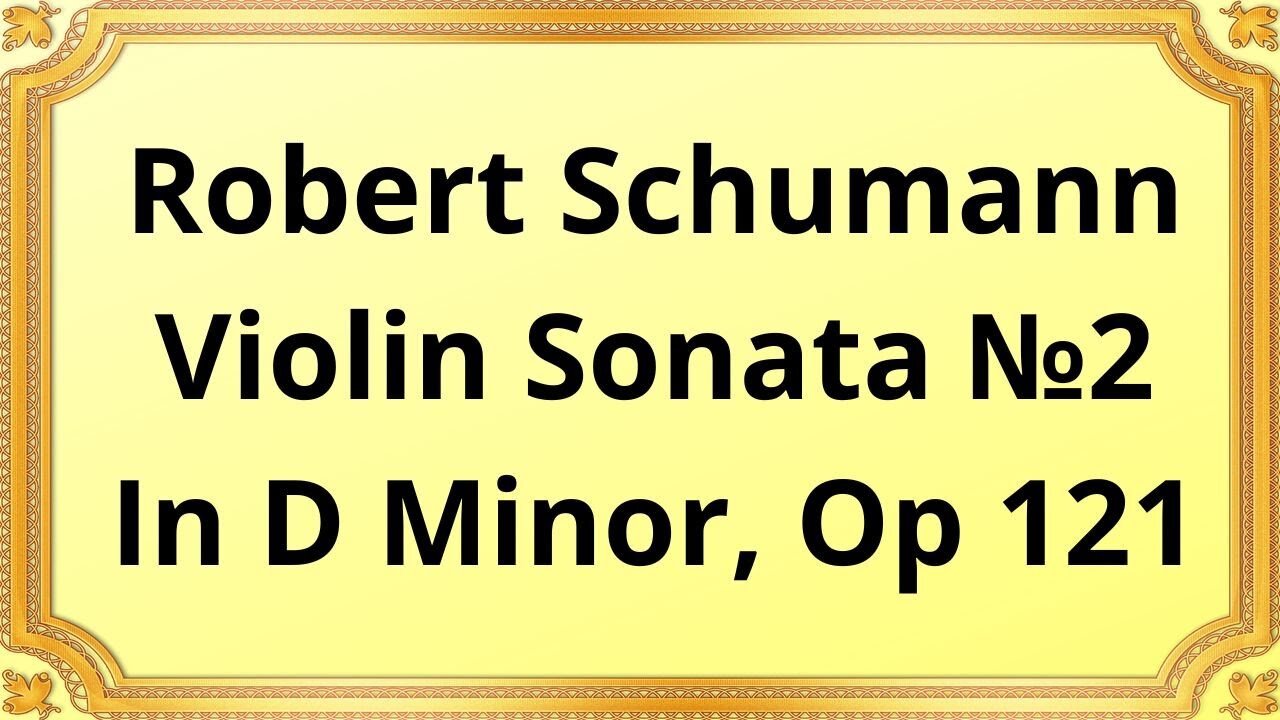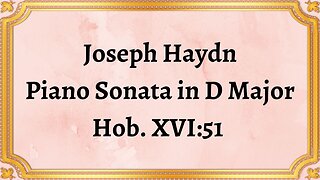Premium Only Content

Robert Schumann Violin Sonata №2 In D Minor, Op 121
#RobertSchumann #ViolinSonataNo2 #Op121 #DMinor #ClassicalMusic #MusicalComposition #RomanticEra #Violin #Sonata #ChamberMusic
PIERRE DOUKAN - Violin
FRANCOISE PETIT - Piano
Robert Schumann's Violin Sonata No. 2 in D Minor, Op. 121 is a captivating composition that showcases the composer's mastery in blending the expressive qualities of the violin with the emotional depth of the piano. Composed during the Romantic era, this sonata is a testament to Schumann's ability to evoke a range of emotions through music.
Composed in 1851, during the Romantic era, Robert Schumann's Violin Sonata No. 2 emerged at a time when composers were exploring new avenues for emotional expression. This period marked a departure from the restraint of the Classical era, allowing for the exploration of heightened emotions and personal expression. Schumann's composition embodies the Romantic spirit, captivating listeners with its emotional intensity and lyrical beauty.
Structure:
1. Allegro: The sonata opens with an Allegro movement that immediately sets the stage for the passionate dialogue between the violin and the piano. Schumann's use of bold and dramatic themes, combined with rhythmic intensity, creates a sense of urgency and anticipation.
2. Adagio: The second movement, Adagio, provides a contrasting atmosphere of profound melancholy and introspection. Schumann's lyrical melodies, accompanied by delicate piano arpeggios, conjure a sense of yearning and emotional depth. The violin and piano engage in a delicate interplay, weaving together moments of tenderness and sorrow.
3. Scherzo: The Scherzo, a lively and playful movement, injects a sense of energy and rhythmic vitality into the sonata. Schumann's use of syncopation and rapid passages showcases the technical virtuosity of both instruments. The movement offers a vibrant and joyful respite from the introspective nature of the preceding Adagio.
4. Presto: The final movement, marked Presto, provides a captivating conclusion to the sonata. Schumann's use of rapid and intricate musical passages creates a sense of exhilaration and urgency. The violin and piano engage in a thrilling dialogue, building towards a climactic finale that leaves a lasting impression on the listener.
Emotional Landscape:
The Violin Sonata No. 2 in D Minor carries the listener through a range of emotions. It evokes a sense of passion, longing, and introspection. The Allegro movement reveals the fiery and intense side of the composition, while the Adagio tugs at the heartstrings with its melancholic melodies. The Scherzo offers moments of lightness and joy, providing a temporary relief before the final movement, which drives towards a powerful and exhilarating conclusion.
Conclusion:
Robert Schumann's Violin Sonata No. 2 in D Minor, Op. 121 stands as a testament to the composer's ability to convey a myriad of emotions through the interplay of violin and piano. This composition exemplifies Schumann's mastery in blending technical virtuosity with emotional depth. The sonata's structure, from the passionate Allegro to the introspective Adagio, the lively Scherzo, and the thrilling Presto, takes listeners on a captivating journey through a wide range of emotions. It is a testament to Schumann's enduring legacy as a Romantic composer and his ability to create music that resonates with audiences, leaving a lasting impact on their hearts and minds.
You have the opportunity to support the channel:
https://destream.net/live/RadSiarAl/donate
https://www.buymeacoffee.com/6355radsiaral
-
 6:07
6:07
Classical music_Music Inspiration
29 days agoJoseph Haydn Piano Sonata in D Major, Hob. XVI:51
771 -
 8:43
8:43
Film Threat
1 day agoTHE MONKEY | Film Threat Reviews
47.2K2 -
 15:55
15:55
TSPLY
1 day agoThe Media Is Very Afraid Of FBI Director Kash Patel
31K29 -
 6:57
6:57
Cooking with Gruel
20 hours agoMake Cheese Great Again
25.7K12 -
 5:17
5:17
Mrgunsngear
23 hours ago $6.04 earnedPresident Trump Has Appointed A New ATF Director
32.6K29 -
 48:17
48:17
Athlete & Artist Show
8 days ago $0.75 earnedS5E1: Chucky Announces First Kid, 4 Nations Face Off, and more!
22.6K1 -
 38:30
38:30
hickok45
8 hours agoSunday Shoot-a-Round # 269
53.7K16 -
 1:39:55
1:39:55
Squaring The Circle, A Randall Carlson Podcast
1 day ago#040 Humanity's Expansion Into The Cosmos: A New Age - Squaring The Circle
30.4K4 -
 12:54
12:54
ariellescarcella
17 hours agoYou're NOT Queer, Just Annoying And Boring
20.3K18 -
 18:57
18:57
Fit'n Fire
14 hours ago $1.29 earnedA PDW That Thumps -- Stribog SP45A3 45ACP
22.3K2